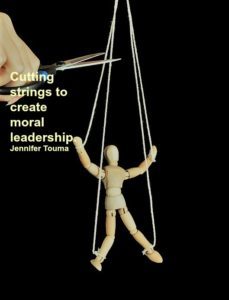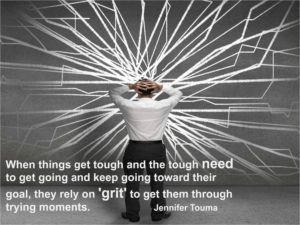Jennifer Touma's Blog
September 27, 2017
Strategies for Constructive Workplace Rebellion

They are leaders of companies and teams. They assert fierce individuality, ignore conventional approaches, and don’t do what they are told. They are the company’s hardest leaders to manage but also good for the company’s bottom line.
Throughout our careers we are told to blindly conform to the status quo, to fit in, and get along with others. Leaders whose behavior is to the contrary are labeled troublemakers, and their behavior is noted on performance reviews.
This article highlights a study by Francesca Gino, Harvard Business School professor, who recently conducted a series of surveys exploring conformity in the workplace. Her findings surveying 2,000 employees showed almost half the participants reported working in organizations where they regularly feel the need to conform. More than half said that people in their organizations never question the status quo. I’d like to explore three of the six strategies her study reveals for encouraging constructive and healthy non-conformity in organizations.
As a lifelong rebel, I was impressed by Gino’s research. Many of my clients have shared with me their version of challenging workplace status quo and I wondered, what if everyone constructively rebelled at work, introducing new approaches without causing destructive chaos?
In today’s business environment, we are probably seeing the conformity pendulum swinging closer to the center, with more organizations changing the way they think about conformity.
1. Gino points to the shame that such giants of industry as Borders, BlackBerry, Polaroid, and Myspace, “once had winning formulas but didn’t update their strategies until it was too late”. They failed to have the insight to know WHEN to move away from the status quo, and not take a wait and see attitude.
The rebel leaders who freely engage in constructive non-conformity ‘play to WIN’ in business, unafraid to take calculated risks that make game changing business decisions. One effective strategy of rebel leaders is constructively questioning the status quo and encouraging their employees to do the same. This can help reignite the business’s pursuit in reaching goals and give employees a reason to stay engaged. Organizations that encourage their leaders to challenge existing practices, asking “why” and “what if”, expand possibilities and generate options.
If these aforementioned companies had applied this strategy, would it have served as a warning system for management that its current business model or processes needed significant retooling to stay relevant – and profitable?
2. Fostering a broader perspective, says Gino, is another strategy for pushing the status quo, enabling employees to view problems from different angles.
According to Gino’s findings, disagreeing with a colleague’s decision by offering a different approach or perspective, can spark new ideas and innovation and “enhance a person’s standing more than conformity can”. Her study pointed out that “a keynote speaker who wears red sneakers, a CEO who makes the rounds of Wall Street in a hoodie and jeans, and a presenter who creates her own PowerPoint template rather than using her company’s” were judged by observers as having higher status than counterparts who conform to business norms. I believe you would agree with me that being exposed to different viewpoints readily fosters different perspectives and more viable solutions.
3. The challenge of leaders, notes Gino, is “learning to balance conformity with non-conformity in a team based environment…” Yet the challenge remains in finding a reasonable balance to promote effective performance. On one hand, a lack in conformity will spur the team to become single individuals creating their own agenda and away from shared goals. Strict and inflexible conformity promotes harsh guidelines that limit taking the initiative to inspire new ideas.
You know from your own experience that both comparisons lead to ineffective performance. But a good balance of both leads to teams that are aligned with leadership and shared goals that are more productive and effective.
Leaders seeking to balance conformity with non-conformity must be open to a positive reciprocal relationship where both leaders and team benefit. Applying the third strategy of encouraging dissenting viewpoints broadens our perspectives, challenges our beliefs, and questions our motivations so that our actions and decisions become aligned with the team and company norms. We can then deliver on the company’s purpose and to the benefit of the organization. Gino’s study notes that “leaders shouldn’t ask, ‘Who agrees with this course of action”‘ or ‘What information supports this view.” Instead, they should ask, ‘What information suggests this might not be the right path to take?'”
Strategies for constructive workplace rebellion.
President John F. Kennedy once said, “Conformity is the jailer of freedom and the enemy of growth.” How does his quote reflect or collide with your own opinion on the subject?
Copyright 2017 Jennifer Touma Mindscape
July 26, 2017
Four Effective Strategies for Neutralizing Toxic People
 We’ve all crossed paths with toxic individuals. They throw verbal zingers, whine, violate confidences, play head games, break promises, and generally get under your skin. It seems you just can’t escape dealing with toxic people. They sit in meetings with you, are part of your team, or were passed from one business unit to another through promotion.
We’ve all crossed paths with toxic individuals. They throw verbal zingers, whine, violate confidences, play head games, break promises, and generally get under your skin. It seems you just can’t escape dealing with toxic people. They sit in meetings with you, are part of your team, or were passed from one business unit to another through promotion.
Now you feel you’re stuck with them, and the rudeness, thoughtlessness and bullying rants they regularly discharge leave you and others feeling devalued, placing your emotional control and healthy mental outlook at risk.
But you can do something about neutralizing toxic people. Here are four key strategies to start:
1. Designate a Toxin Handler
A toxin handler is a natural leader within your business who can help employees deal with organizational life. The toxin handler can help soften the blow that triggers feelings of powerlessness when dealing with a new boss, or changes in policy or company structure. They run interference to avoid potential toxic occurrences and workplace violence. They counsel, advise, and shield employees from the wrath of angry managers, in order to minimize disruption of the individual or team’s normal flow of work, productivity, and operations.
2. Pace and Lead
One of the tenets of NLP® NeuroLinguistic Programming is moving the person from their current negative emotional state to a desired state using a process that involves pacing and leading.
Pacing means almost matching someone’s posture, breathing rate, tone and volume but avoiding any volume or tone that might escalate the situation. Listen carefully for their story to understand the mental map of their world. Occasionally shift your posture, slow your breathing or uncross your legs, to demonstrate you are dealing with the issue, and not confronting the person.
Summarize their story by feeding it back to them using their language of what is happening now, based on what you believe is true about their experience. Connecting their problem or complaint to a solution or answer helps them think, feel, or do better.
By establishing rapport, the other person will follow you. If they don’t follow your lead, you can do some more pacing until they are ready.
3. Define Boundaries
Eliminate frustration and ambiguity for everyone by defining job responsibilities, roles, and expectations. Make it clearly-defined, concrete, behaviorally-specific and put it in writing for future referral. Make certain Standards of Behavior an expectation with a clear explanation of consequences for not following them. As an organizational leader, you must “walk the talk” yourself.
4. Maintain Your Leadership Role
Toxic people enjoy getting under your skin to undermine your confidence. When they do, keep your demeanor composed, confident and decisive. Resist the emotional pull of the moment. Take the time to think and respond in a controlled and deliberate way.
Don’t give toxic people a free pass just because you value their skills and productivity. Clearly explain the consequences of their actions no matter how effective they are in their respective jobs.
Dig deep to get a closer look at what is driving their behavior, whether related to career development, home life or work environment. Offer counseling and resources to help them alleviate the underlying issue.
Make behavioral standards part of a periodic performance review process. Once behavioral standards are in place, utilize 360-feedback, and document performance.
—Handling toxic people as a leader involves tough decision making. Are you making the hard decisions and taking the steps to neutralize toxic people, or are you avoiding them?
If you like this post, I invite you to share it.
Copyright 2017 Jennifer Touma Mindscape
June 23, 2017
How Mentally Strong Leaders Use Manipulation For Moral Leadership
 Do you recall talking with a colleague or employee about a topic where you expressed your opinions, they expressed theirs, and how they differed. Yet when you left the conversation, their opinion dramatically shifted to your point of view. And during the exchange, you believed in your heart that if they implemented your recommendation it would have a positive impact on the way they see their leadership style both on a personal and professional level.
Do you recall talking with a colleague or employee about a topic where you expressed your opinions, they expressed theirs, and how they differed. Yet when you left the conversation, their opinion dramatically shifted to your point of view. And during the exchange, you believed in your heart that if they implemented your recommendation it would have a positive impact on the way they see their leadership style both on a personal and professional level.
What role does manipulation play in this situation?
Manipulation is DISGUISED as influence. The meaning of manipulation depends on the context of the situation in which it is used.
Do you manipulate to influence a situation that turns bad to good, or manipulate to influence a business opportunity or move a person to action, or use manipulation as a weapon for the purpose of immoral influence?
One thing is certain about manipulators, they are skilled at taking control of any mind that is weak and undisciplined. Anyone with marginal awareness skills is an easy target for manipulators. They revel in the thought of testing our mental toughness and our determination to resist the manipulative pull of the moment.
What common traits exist between the skills of manipulation and leadership?
You should not be surprised to hear that many commonalities exist between leadership and manipulation. These include:
• The ability to inspire others to take action.
. The use of intention.
• The ability to affect the individuals’ psychological and emotional state of mind.
If the commonalities are the same, what is the difference between a leader who manipulates people for the purpose of benefiting others, and a leader who employs manipulation as a weapon to benefit their own agenda?
Leaders fueled with immoral intent use manipulation to fool, control, scheme, or exert unjustifiable influence over a person or situation, exploiting the victim to serve their own agenda. At one time or another, we have all been at the receiving end of their skilled wickedness only to realize later what happened. But how do you know you are being manipulated in a negative fashion?
Self-serving manipulation involves a leader who
• Twists your words to mean something other than your intent to serve the leader’s own agenda
• Magnifies your weaknesses and insecurities so you feel wholly dependent on their guidance
• Redirects opinions you express with ambiguous responses for the purpose of leaving you confused, bewildered and under their control
Leaders fueled with moral intent, by contrast, apply manipulation to sway others to positive action, help them bounce back from a setback, make wise decisions, or guide them toward achieving a purpose that benefits them and their environment.
How do you know you are being manipulated for the better?
When you
• Show greater confidence in using a skill that once limited your options
• Feel mentally and emotionally ready to perform better and move through life with more zeal and motivation
• Express more passion in the meaning of the work you do, exhibiting the energy and desire to do more and contribute more
As professionals committed to moral leadership, we have an uncompromising duty to use our influential skills with awareness and intent. When you apply it with extreme care, and are mindfully aware of its end result, you create a remarkable brand of
leadership.
Influence has long been seen as an integral part of leadership. Why not make yourself the kind of leader who has the ability to use manipulation that benefits everyone, personally and professionally?
Copyright 2017 Jennifer Touma mindscapemind.com
May 10, 2017
Mentally Strong Leaders Value Moral Capital

Mentally strong leaders give higher priority to moral capital, a value – based code for living that distinguishes between right and wrong.
In his 2003 book, “The Moral Capital of Leaders: Why Virtue Matters,” author Alejo Jose G. Sison observes that in the Enron scandals, “no amount of human, intellectual or social capital could make up for the lack of moral capital among workers for the long-term success of the enterprise.”
Moral capital is the invisible fiber of integrity, trust and influence each of us has that is an inner-directed goal of holistic means feeding the whole person that shape our character and our life.
Dynamics of Moral Capital
We accumulate moral capital through experiences, achieving success in winning challenges, cultivating relationships, and meaning what we say. It becomes visible through our actions.
Government leaders use their hard-earned political capital to win over support for an idea, resolve a conflict, or impose new policy. A company benefits by the positive influence virtuous employees exert on the corporate culture, with increased interaction with upper management, maintaining engagement, and giving meaning to their jobs, diminishing the propensity of employee or corporate wrongdoing.
Mentally strong leaders understand two conditions associated with possessing moral capital. If you try to stock pile it, it slowly fades away. And if you use it unwisely, you’ve misspent it, and it’s gone.
To lead means to make decisions. To appear unable to make decisions is to appear unable to lead. Every decision comes with risks and consequences with enormous personal political capital risk.
Moral capital does not discriminate between individuals and organizations. Does moral capital matter in decisions? If so, should individuals or businesses focus solely toward good, or should the purpose of business solely be directed on maximizing shareholder returns?
Your Two Opponents
Leaders worth their salt in projecting moral capital through strength must face and overcome internal and external opponents. Your internal opponent is a cunning foe that knows your weaknesses and will stop at nothing to break down your moral capital. It listens to your fears, anxieties and self-doubts, striking when you are at your weakest.
Your external opponent consists of followers, colleagues, and friends who attack your every decision, policy or change. They’re betting on your failure. This foe appears whenever you stumble or whine about your work, or fail to fulfill a promise you made.
There are two ways mentally strong leaders develop a higher level of moral capital for long-term personal success.
1. Accessing the Brain’s Executive Center
Mentally strong leaders purposely access the Executive Center of their brain, located in the frontal lobe, sometimes called the CEO or hallmark of human intelligence. It links and integrates all components of behavior at the highest level, from planning a vacation to organizing a meeting. It is the seat of identifying goals and strategic ability, thinking and decision-making ability, free will and firm intention.
Your moral capital is a reflection of the thoughts and actions of your executive center that shape your character and life. Use your moral capital wisely in pursuit of purposeful leadership and in being authentic, because whatever you do today will resonate in the future.
Although leadership can prove to be stressful and exhausting at times, a leader’s character will be tested, and judged, by how they respond to everyday situations and challenges. Mentally strong leaders in every field must accept that they, and they alone, influence their own performance and shape their own character. They are keenly aware of its broadest influence when accessing it to intentionally lead, make strategic decisions, and modify the attitudes, beliefs, values, or behaviors of their followers.
2. Challenging Unspoken Assumptions
An assumption is an underlying belief that the subject matter is accepted as true or certain to happen, without proof. The mentally strong are quick to challenge assumptions because they see it as an opportunity to maximize future possibilities and welcome it as a mental test of perseverance and resolve.
In contrast, weak minded, lazy individuals purposely duck this path and immediately accept assumptions as true. This is risky because it restricts growth, diffuses confidence, and causes unintended consequences.
Feed your moral capital with a desire for knowledge that breaks down the limitations holding you back. Ask questions to ignite positive action. Ask yourself, is it true? And, what am I accepting about my business and in my life that is controlling me?
How will possessing moral capital matter in your life, in managing people, and leading your business?Mentally strong leaders value moral capital.
If you like this post, I invite you to share it.
If you would like to learn to be more influential in business and life I invite you to contact me here.
Copyright 2017 Jennifer Touma Mindscape Mindscapemind
Certified in NLP and mental game/mental toughness coaching, M.S. in Organizational Leadership Norwich University
April 12, 2017
Why Character Counts in Mentally Strong Leaders
 Symphony of Love via Flickr by vzoesto
Symphony of Love via Flickr by vzoesto
Character counts in life. Or at least it used to! The never-ending litany of crises and scandals in business, politics, sports and the news media highlights the need for leaders who display character.
Without question, character is the most influential trait an effective leader can possess. This doesn’t mean other leadership competencies are less important, but rather that character is a mirror reflection of who an individual is, shaped from their responses and reactions to overall life experiences.
What Character Means
Character is defined as a combination of moral and ethical traits, personality traits, and values that enable leadership excellence. Warren Bennis PhD, in his book, On Becoming a Leader, states “Excellence starts with leaders of good and strong character who engage in the entire process of leadership. The first step is being a person of honorable character.”
Although there are numerous tenets to character, here are the top 5 that enable me, personally, to stay true to myself and be effective without compromise:
Intention
I believe in leading by intent rather than chance. If you lead by intent, your impact on others is demonstrated by intentionally modifying your followers’ attitudes or behaviors and controlling the degree of change in a person’s behavior or attitude as a result. If you lead by chance, you’re leading by autopilot, leaving your followers at the mercy of reckless decisions.
Timing
Over the years, I have learned that successful leadership involves the ability to understand the rhythm and timing in everyday situations. My leadership effectiveness depends on my acute awareness to sense the rhythm affecting any situation and being able to determine the right timing to make a move and when to stand still.
Response to Adversity
When confronted by adversity, you will likely do one of two things. You’ll disengage from it, not acknowledging its current and future affect, or you’ll view it as a “life skill”, a survival mechanism in improving motivation in response to certain situations.
Mental Strength
Although the leadership journey can occasionally be exhausting and stressful, a leader’s character is tested, observed, and judged daily by how they respond to situations and challenges. Mentally strong leaders in whatever field they excel accept that they and they alone influence their own performance and shape their own character.
Character Development
Character is not a fixed trait, but one that is constantly developing over time from several sources. Some leaders develop their character in the trenches of life experiences, while others learn it from a book that gives them knowledge, or guided by a coach or mentor. Here are two key ways of developing strong character:
Learn how to walk in the other person’s shoes to influence others mindfully and intentionally. This means you step into their mental map of the world, gaining an appreciation of how they perceive a given situation.
Shake up your routine to deliberately disrupt your pattern of behavior that represent the status quo in order to encounter new challenges.
How do you, and others, evaluate the character you exhibit as a leader? And does the character you exhibit inspire others toward progress, cooperation and achievement?
Why character counts in mentally strong leaders.
I invite you to share this post with colleagues, family, and friends.
Copyright 2017 Jennifer Touma Mindscape ǀ Mindscapemind.com
March 1, 2017
How Mentally Strong Leaders Influence Using the NLP Mental Map Model
 Most of us at some point in our careers have experienced a boss or co-worker who exerted their influence by means of control. Controlling methods include instilling fear, verbal or physical threats, insisting on a ‘do as I say mantra’, and breaking the rules.
Most of us at some point in our careers have experienced a boss or co-worker who exerted their influence by means of control. Controlling methods include instilling fear, verbal or physical threats, insisting on a ‘do as I say mantra’, and breaking the rules.
Today I want to show you how mentally strong leaders use the NLP ‘mental map’ influence model. This is designed to help * Make you more influential * Deepen your rapport and connections with others * Create congruence in thinking, emotions, and actions
INFLUENCE IN THE WRONG HANDS
We know that influence in the wrong hands, leaders who knowingly leverage people and situations for their own agenda, crosses over an ethical line into manipulation or even mental or emotional abuse.
That is why it is important that mentally strong leaders exert the ability to harness several personal assets. These are mindful awareness of others beliefs and expectations, demonstrations of empathy, and drawing on leadership skills to adjust their style to exert positive influence over others.
POSITIVE INFLUENCE
To sustain positive influence in others is the ability to mindfully and intentionally modify followers’ behaviors, beliefs and attitudes, thereby controlling the amount of change in a person’s attitude or behavior as a result. This process leaves them congruent mentally and emotionally, with an outcome that has them situated in a ‘good place’ for all involved.
But in order to influence others mindfully and intentionally, you have to walk in the other person’s shoes. This means you step into their mental map of the world, gaining an appreciation of how they perceive a given situation.
Since no two people are alike, no two mental maps are alike. One of the challenges every leader faces is dealing with the different ‘mental maps’ of the people they lead.
DEFINING MENTAL MAP
Our ‘mental map’ is a road map for living our lives and making sense of the world. This map is formed from factors such as our beliefs, values, experiences, past traumas, attitudes, upbringing, schooling, habits, and behaviors that provide us with a lens through which we see the world. We will always respond to the world according to our individual mental map.
What causes one person to be an engineer, another a sales associate and yet another an accountant or teacher? Why are some people successful and others find success elusive? Your mental map exerts great influence.
GAINING POSITIVE INFLUENCE
The following tips can make you more influential, deepen your rapport and connections with others, and create congruence enabling others to act with purpose.
1. Be in a receptive state of mind by freeing your mind from making assumptions. Avoid making preconceived judgments before you have all necessary information in hand.
2. Ask open-ended questions to elicit information that helps you gain a better understanding of their situation.
3. Suppress your internal dialog. Watch, listen and sense any changes in your followers’ emotional state and body language.
4. Listen to the other person’s choice of words. Words speak volumes about how they think and feel, reflecting their inner experiences.
5. Think about the statement “I can’t do that here.” It’s indicative of limited thinking, meaning they feel they have no choice. ‘I” is the person’s identity; ‘can’t’ relates to their limiting belief; ‘do’ expresses their capability; ‘that’ indicates a behavior; and ‘here’ is the environment.
6.Expand their possibilities by suggesting they replace “I can’t” with “I won’t.” Have them ask, “What specifically can’t you do, or won’t do?” or “What would happen if you did, or did not, do that?”
In everyday context, this is one NLP model that gives you an effective way to gather information respectfully and gain an insightful inside look into another person’s ‘mental map’ of their world. It enables you to help them be more congruent in thought, emotions and action.
If you like this post, I invite you to share it.
Copyright 2017 Jennifer Touma Mindscape Mindscapemind
What is Mental Toughness? Mental toughness is the quality that enables us to excel, be resilient and emotionally steady in difficult personal and professional situations.
What is NLP?
*Neuro – is how we think
*Linguistic – how you communicate your thoughts to others. Body language, gestures, facial expressions and movement are all non-verbal cues that express what words may not.
*Programming- the habits we develop daily
January 26, 2017
How Mentally Strong People Use NLP Methods to Resourcefully Manage Conflict
 When two individuals or groups of people are in conflict and lack agreement about something, they continually butt heads. Disagreements often arise because they see the situation from different points of view.
When two individuals or groups of people are in conflict and lack agreement about something, they continually butt heads. Disagreements often arise because they see the situation from different points of view.
The path to agreement requires that both parties elevate their thinking to a higher level that takes into consideration all concerns, perceptions and frames of reference.
Here are two ways that mentally strong leaders use NLP methods to resourcefully manage conflict:
1. Practice one of three basic positions known as Perceptual Position, a particular perspective or point of view. In NLP there are three main positions you can take in your view of conflict:
(a) The first position involves experiencing the conflict through our own point of view. This allows you to directly associate with the experience and think, “How does this communication or conversation affect me?”
(b) The second position has you walking in the other party’s shoes. Take into account how your communication with the other party would look, sound, and feel like from their point of view. This enables you to experience empathy by stepping into their mental map of their world, gaining an appreciation of how they feel about your conversation and actions as well as deepening rapport with them.
(c) The third position is as an independent observer, an external viewer seeing yourself and the other party disassociated from the conflict or conversation. This position helps you to objectively inquire, “How does this conflict or conversation look to someone who is totally uninvolved?”
Be aware that perceptional positions shift during interaction. You may begin in first position, and as the conversation or conflict develops, find yourself shifting into all three positions. Shifting will trigger new ideas and solutions, asking engaging questions or telling stories that help the other party immediately identify with the purpose that leads to agreement or resolution.
Which default Perceptual Position do you favor the most?
2. See the Conflict Resolved from a Future Perspective: Experiencing a situation in the future is called future pacing in NLP. You mentally rehearse a situation before it happens, envisioning the desired outcome as you want it to be.
a. First, in your mind’s eye, create the setting where you’ll see yourself and the other party. rehearse a situation before it happens, envisioning the desired outcome as you want it to be.
b. Second, imagine the sensations of seeing what you see, hearing what you hear, and feeling what you feel in the context of your situation.
c. Third, see yourself projecting positive body language, communicating with the other party, displaying confidence and a sense of accomplishment.
If the conflict has already escalated, you can still apply future pacing by acknowledging where you are in the conflict, then mentally rehearsing the three steps above. Ask yourself, “What can I say or do that would diffuse the conflict or change its path to arrive at a resolution?’’
If you like this post, I invite you to share it.
Copyright 2017 Jennifer Touma Mindscape
Neuro-Linguistic Programming, NLP is the art and science of excellence that leads to personal effectiveness and a better understanding of human behavior. It is a set of models, skills and techniques for thinking and acting effectively in the world. It enables people to experience a more balanced and joyful life without self-imposed limitations.
Jennifer is certified as a metamaster practitioner in Neuro-Linguistic Programming.
November 15, 2016
The Secret Weapon of Mentally Strong Leaders

Conference participants ask me all the time for that ONE word or magical phrase, tip, or technique that would give them more influence with their team, colleagues and clients. The ability to persuade others is one way we get people to achieve sales quotas, secure promotions and be offered jobs, win contracts, or even have the furniture rearranged to our liking in the office.
I could give you that one word or tip, but it is only a quick fix that vanishes any possibility for long term solution – then the cycle begins again.
Becoming an Influential Leader is what you are here to learn – the soft skills and the inner qualities that builds character and mentally makes you feel fit to lead a business unit, a classroom of students, a corporation, a foundation, or your own business as a solopreneur.
My years of experience in leadership and business, combined with my studies in mental toughness, lead me to say that the power to influence others with awareness is one of uncompromising mental toughness that expects you to be intentional on who you use it on. When you apply it with extreme care, and are mindfully aware of its end result, you behave like a mentally tough leader exerting two distinct choices:
1. On the awareness level, your impact on others is demonstrated by INTENTIONALLY modifying your followers’ attitudes, beliefs, values, or behaviors and controlling the degree of change in a person’s behavior or attitude as a result. So choose your words carefully, create authentic conversations, be mindful of how people read your tone of voice as well as your body language. Body language, gestures, facial expressions and movement are all non-verbal cues that express what words may not. Optimize your thinking skills with alone time, because alone time often increases creativity and productivity and replaces rigid thinking to become more flexible and choice driven.
2. On the unawareness level, your ability to leverage people and situations to your advantage is left to CHANCE. This means you’re clueless as to the power your words, behaviors and attitudes have on others. This is a dangerous leader, one who is on autopilot. A leader who sends mixed signals leaves their followers at the mercy of unfiltered words and reckless thinking, stirring anxiety and discontent. If you go about your day leading others aimlessly, you experience more failures and fewer successes, feel more frustration and less satisfaction, and there’s a huge likelihood you will have experiences you want to avoid instead of beneficial ones that move you forward.
Influence has long been seen as an integral part of leadership. Does every leader have the ability to become a good influencer?
Can you think of some examples of influence that are in reality manipulation rather than true leadership?
If you like this post, I invite you to share it.
Copyright 2016 Jennifer Touma Mindscape
October 7, 2016
Ten Types of Leadership Flaws Build Mental Toughness
 Mentally strong leaders acquire the skill of mental toughness over time. To achieve mental toughness, you must get comfortable and make friends with uncertainty, shifting business environments, and innovation. Although the leadership journey can occasionally be exhausting and stressful, your demeanor must appear composed, confident and decisive as if everything were business as usual.
Mentally strong leaders acquire the skill of mental toughness over time. To achieve mental toughness, you must get comfortable and make friends with uncertainty, shifting business environments, and innovation. Although the leadership journey can occasionally be exhausting and stressful, your demeanor must appear composed, confident and decisive as if everything were business as usual.
My own experiences have taught me that mental toughness begins when you catch yourself intentionally overriding the flaw that sabotages your goals. And this is never so true as when you are being ambushed by any one of these ten leadership flaws:
1. Failing to adapt to the shifting business environment, an inability to realize that many business situations require a different set of leadership behaviors, skills, and solutions. If you persist in acting the same way even when it’s no longer appropriate to new context or circumstance, your actions will not be supported by the organization.
2. Not detaching yourself from emotional conflict. Immersing yourself into a charged situation takes away your objectivity to act with purpose and think clearly. And the emotions will be about the experience rather than you and the participant.
3. Lack of effective communication. Without clear communication, you will never get the response you want or expect, derailing your goals.
4. Failure to develop relationships, treating people as objects, insensitive to their needs. Remember the old adage: be careful how you treat others going up the ladder, because you may meet them again on your way down.
5. Lack of emotional control, acting on impulse and failing to resist the emotional pull of the moment. Emotions, rather than clear purpose, will drive your actions in response to people and situations.
6. Lack of accountability, not being responsible for your own actions and behavior. Playing the victim role only leads to finger-pointing, blaming others, and an undesired outcome.
7. Being easily intimidated. If you back down quickly when challenged, or are intimidated by competence or excellence in others, you will continue to feel inferior. Eleanor Roosevelt once wisely noted, “No one can make you feel inferior without your consent.”
8. Whining and complaining about the way things are. Stop wasting time blaming others for your mistakes and realize no one is listening. In business, as in life, we all make mistakes and experience setbacks and disappointments.
9. Not developing others. Don’t assume that your followers have an understanding of their work and responsibility. Find ways to further develop everyone’s knowledge, skills and resources.
10. Not delegating. You are not the only person who can do the job well. Failure to delegate means you won’t develop employee business acumen, win their confidence, and help build the skills, knowledge, and experience they need to make good decisions.
Leadership effectiveness and ongoing success is a journey in mental toughness. There is one important truth to know. Mental toughness is a fundamental skill set you need to possess. Without it, you can’t improve performance, or effectively think, act, or innovate. And you certainly can’t inspire the best in others. If you find yourself continually exhibiting the ten aforementioned flaws, you should think carefully about your desire and readiness to be in a leadership role. Seek the services of an executive coach or sign up for a course in skill development.
If you like this post, I invite you to share it!
Copyright 2016 Jennifer Touma Mindscape Mindscapemind
August 18, 2016
How Olympian “GRIT” Influences Your Career and Your life

The Olympic Games brings together to the world the best athletes in every sport to demonstrate their mastery through competition. The athletes’ preparation is meticulously ongoing and demanding both physically and mentally. When their mental toughness is tested, they rely on gritty backbone, an unwavering dedication to help guide them through trying moments, remaining focused on their desired goal. The difference between an amateur and a true Olympian is how much discomfort and emotional and mental pain a person is willing to endure to achieve what they want.
Like the Olympians, we too must draw on our psychological preparedness, in leaving nothing to chance by meticulously preparing not only for situations or events we expect, but also for unexpected events. Preparing ourselves to display mental toughness and resiliency in advance gives us two vital advantages: first, it multiples our chances for success; and second, it helps us exceed our original expectations in anything we attempt, especially when quick decisions are required.
When you adopt the Olympian attitude, which characteristics displaying grit do you call upon to give you the psychological strength to embrace resiliency and keep going? Compare your own behavior and mental attitude to this list of ways to display true grit:
1. Demonstrating the Courage and Confidence to take the road “less traveled”, not to pull back or play it safe, taking a wait and see attitude. Assuring yourself you can do what you can do right now in the present moment.
2. Having the Mental Agility to take a clear line-of-sight of both smooth paths as well as obstacle courses, successfully and repeatedly zig-zagging your way to successful solutions rather than following a straight line to reach any goal.
3. Feeling Resilient no matter what happens in the moment. Demonstrating resilient thinking determines that your actions influence the result rather than jumping back into action from habit rather than inspired by conscious thought.
The articles below are a quick read to give you different characteristic views of ‘grit’ and to spark positive mental energy when things get tough and the tough need to get going and keep going toward achieving their goals.
How to Radically Improve Your Mental Willpower Through Navy SEAL Tactics
The secrets used by Navy SEALs and US Olympians to build mental willpower.
Could you think positive thoughts if you were running out of oxygen and drowning? Read more
Source: The Mission
————————————————————————–
What the Most Resilient People Have in Common
Aug 9, 2016 | Mental Toughness, US
When the going gets tough the tough stay connected, positive and resilient.
The truth is that life can be tough, business can be hard-hitting and success comes with challenges. What separates those who can hold their own and keep going in times of adversity is a cluster of habits that center on resilience.
Resilience means developing a strong solid level of mental toughness. We aren’t born with it–it’s a habit you develop, a skill you learn. And it’s absolutely essential.
Read more here about four core habits of the most resilient people
Source: Inc.com
———————————————————————–
Tony Robbins on Why ‘Action is the Key to Everything’
Tony Robbins, life coach and author of Money: Master the Game, explains in this 2 minute video why 80 percent of success is psychological. Find out why here
Source: Inc.com
If you like this post, I invite you to share it!
Copyright 2016 Jennifer Touma Mindscape



